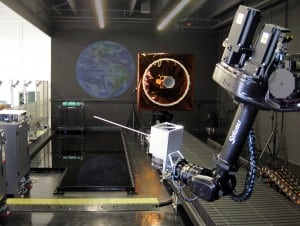Latest News

ATK’s Robotic Rendezvous and Proximity Operations (RPO) Lab in Beltsville, MD, demonstrates satellite life extension technology with simulated satellite and docking maneuvers. Photo: ATK
[Via Satellite 06-04-2014] After getting a boost during panels and conversations at the SATELLITE 2014 Conference and Exhibition in Washington, D.C. last March, in-orbit satellite servicing seems to be moving back to the surface. Asia Broadcast Satellite (ABS) CEO Tom Choi, in particular, expressed notable interest at the show for possibly lengthening the life of ABS’ satellite constellation. ViviSat, one of the companies working on this topic, is steadily progressing with its in-orbit life extension and protection services program. The company already has more than half of its Mission Extension Vehicles (MEVs) signed for first customers.
“Three of our first MEVs are now booked with two clients, so we’ve seen that as early, positive evidence and validation from the market. We also see this progress as evidence that there is a larger demand for our MEV product,” Bryan McGuirk, COO of Vivisat told Via Satellite.
Working closely with founding investors ATK and US Space, Vivisat is developing spacecraft that can attach to a satellite near the end of its life and propulsively open up new options for operators. With this service, the company is targeting operators with satellites parked in Geostationary Orbits (GEO). Once these satellites run out of fuel, ViviSat’s MEV can attach to it, refuel and even reposition the spacecraft. However, McGuirk said ViviSat’s current customers are showing preference for services beyond merely sustaining a satellite as is.
“Traditional life extension where our MEV docks and extends the life of a satellite is certainly in demand, but there is a unique mission that we have had a significant amount of demand for at the beginning: using our MEVs to prove out new slots and new missions on orbit,” he said. “A number of our first clients are taking satellites at the end of their [lives] and moving them to new slots that they have desired to expand their franchises. [They are] using our MEV and leveraging the leased service model to discreetly test out these slots in a capital-efficient way.”
According to McGuirk, ViviSat customers plan to use MEVs to reach new markets with older satellites. This in turn could lead to the decision to build a new satellite once a slot’s value has been proven. It is not uncommon for operators to hold onto unused orbital slots. These locations stand as opportunities for future satellites should they be deemed profitable.
“The opportunity is to move an MEV to one of those new slots and bring on new clients that are paying,” explained McGuirk. “In this case our clients are not just preselling an idea, but a real service with a real satellite delivering to those clients. Using the ViviSat MEV allows our clients to more effectively prove the business case for these new locations.”
The MEVs are long-life assets, not unlike a Fixed Satellite Service (FSS) satellite. According to McGuirk, each has a design life of 16 years, with fuel to go on past that if needed. This provides the opportunity to use the same MEV for multiple customers.
“Each mission that we will be servicing will be approximately three to five years,” said McGuirk. “We can dock, provide service, undock and move on to another client. We currently have orders for first clients for three MEVs. Later missions are too far in the future for operators [to] have line of sight yet. We will be selling those missions in future years.”
Satellite operators, especially in FSS, tend to be fairly risk-averse. In-orbit servicing, though not a new idea, requires tasks such as rendezvousing in orbit, which take a great deal of precision and care. ATK has dedicated much of its involvement to practicing rendezvous, proximity and docking features at a large robotics laboratory. The company is using an air-bearing floor among other technologies to simulate docking in a zero gravity environment.
“What we are about here is a real ‘keep it simple’ approach that has a significant amount of in-orbit heritage for the equipment, technology and processes that we are using,” said Joe Anderson, chief engineer and director of MEV services at ATK. “Really we don’t foresee big technical hurdles in the type of mission we are doing because of the simple approach we are taking.”
McGuirk added that at this point the MEV’s technological design is “very mature,” and that this has allowed ViviSat to pin down some of the costs. In addition to the financing received from ATK and US Space, Vivisat is talking to debt and equity investors to round out its complete financing. McGuirk said he expects the project to reach a fully funded status by the end of the year.
“At ATK we provided Vivisat with a firm-fixed price for the build, launch support and operation of these vehicles,” added Anderson. “Our design is far enough along that we can establish a firm-fixed price contract for the vehicle builds.”
Both McGuirk and Anderson said they have not changed their strategy for ViviSat following the announcement of the merger of ATK’s Aerospace and Defense branch with Orbital Sciences to create Orbital ATK. The multi-billion dollar transaction is expected to close by the end of the year. Though the merger could certainly open up more options for ViviSat, for the time being all companies involved are continuing with previous plans to bring the MEVs to market.
“We have heard positive comments from David Thompson from his initial investor calls related to satellite servicing, so we see that positively; but honestly, for us, we have our head down and we are very focused on business as usual,” said McGuirk. “We have not changed what we are doing and the strategy remains the same.”
Get the latest Via Satellite news!
Subscribe Now